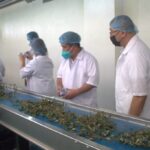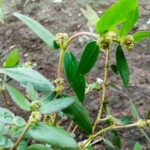Changing the Face of Philippine Herbalism ─ The Manila-Acapulco Galleon Trade
 Herbalism in the Philippines, as in much of Southeast Asia, shares a common
Indo-Malayan heritage that has been enriched through centuries of trade with
China and India. The colonization of the Philippine Islands by Spain starting in
the 1600s however considerably changed Filipino folk healing practices as many
new exotic plants were introduced in the country, enriching the medicinal chest
box of the Filipino arbularyo.
Herbalism in the Philippines, as in much of Southeast Asia, shares a common
Indo-Malayan heritage that has been enriched through centuries of trade with
China and India. The colonization of the Philippine Islands by Spain starting in
the 1600s however considerably changed Filipino folk healing practices as many
new exotic plants were introduced in the country, enriching the medicinal chest
box of the Filipino arbularyo.
The Manila-Acapulco galleon trade was established In 1565, providing direct linkage of the Philippines to the New World and the Old World. This was the actually the first global trade route in history and the longest in its time, covering 15,000 miles in its full length. This connected Spain to the Philippines, linking Seville with Veracruz in its Atlantic phase, then Mexico City and Acapulco overland, and eventually Manila across the Pacific Ocean.
During a 250-year period, a total of at least 200 galleon crossings were made across the Pacific Ocean between Manila and Acapulco. Manila became the center of trade in the region, moving goods from China, Japan, and Southeast Asia, to Europe through Spain. The galleons came back to Manila from Acapulco bringing silver from Central and South America, goods from Europe, and among other things many new useful plants for food and medicine, ornamental use, as well as for timber.
The list of medicinal plants introduced to the Philippines from the New World is long. To name a few are the akapulko (Cassia alata), ipil-ipil (Leucaena leucocephala), sabila (Aloe vera, and oregano/suganda (Coleus aromaticus). Food plants with medicinal value on the other hand include atis (Annona squamosa), avocado (Persea americana), balimbing (Averrhoa carambola), bayabas (Psidium guajava), dalandan (Citrus aurantium), guyabano (Annona muricata), kaimito (Chrysophyllum cainito), kakaw (Theobroma cacao), kamoteng kahoy (Manihot esculenta), kasuy (Anacardium occidentale), papaya (Carica papaya), piña (Ananas comosus) and siling labuyo (Capsicum frutescens). Examples of economically important tree species which have also found use in Filipino folk medicine are acacia (Samanea saman), kakawate (Gliricidia septium), and mahogany (Swietenia macrophyliai).
Medicinal herbs originating from the Old World with no doubt also reached the Philippine shores through the galleon trade and these likely include the balanoy (Ocimum basilicum), damong maria (Artemisia vulgaris), yerba buena (Mentha x cordifolia), dumero (Rosmarinus officinalis), and comfrey (Symphytum officinale).
While the Manila-Acapulco trade abruptly ended in 1815 during the Mexican War of Independence, it forever changed the flora in urban and rural centers throughout the archipelago. From the Philippines, several of these New World and Old World plant introductions were eventually exported to other countries in the region.
An interesting footnote in history is the sweet potato (Ipomea batatas), locally known as kamote, which was brought to China as an alternative food crop after a famine hit Fujian province in 1593.
To commemorate the unique role of the galleons in Philippine history and the Asia-Pacific region’s history, the country celebrated last October 8, 2010 the 1st Dia del Galeon Festival. The event was highlighted with a weeklong activity and the docking in Manila, Cebu, and Bohol of the Andalucia, an impressive 17th century replica of the Spanish galleon.
Clearly, it is difficult to imagine how Filipino folk medicine and Filipino culture in general would be today without the Manila-Acapulco galleon trade. For sure, the Department of Health’s “sampung halaman” will be listed differently and we will be singing a very different “bahay kubo” song.







